Francesco Spampinato | Data Relief
Keywords: 60s, 70s, accelerationism, Aphex Twin, Brian Eno, Brion Gysin, brookstone, Carsten Nicolai, data relief, hallucination, LSD, Mariko Mori, non-places, Oneohtrix Point Never, relaxation, SkyMall, speculative realism, surrealism, synaesthesia, Therapy, vaporwave, wearables. sharper image
From surrealist tech to accelerationist sci-fi: a radical history of wearable gadgets
Accelerating Brainwaves
Devices promising to manage stress, sleep disorders and give relief from “exhausting” daily life are nothing new. Pinhole glasses with black perforated lenses, also known as stenopeic glasses, have been sold since the 1950s with claims to improve eyesight and “relax tired eyes.” More advanced devices entered the market following the growing amount of data and digitalization. Gadgets retailers Brookstone, Sharper Image, and SkyMall sell automated head massagers, sleep masks emitting photoluminous glows and air pressure-based tools that “rejuvenate” muscles and joints of hands that have performed too many repetitive motions on a mouse.
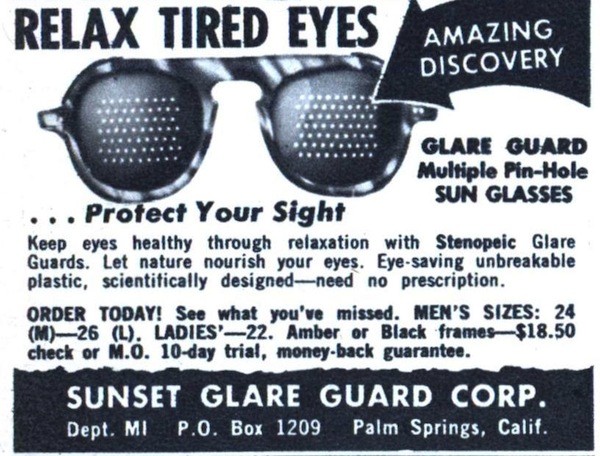
Relax Tired Eyes, Sunset Glare Guard Corp., Palm Spring, California – ad, circa 1950s
One by one these companies declared bankruptcy, and now lie in the hands of global firms investing in the development and distribution of more sophisticated machines sold online or through third party retailers. Brookstone and Sharper Image started as catalog businesses; the former, in 1965, was selling hard-to-find tools to hobbyists; the latter, in 1977, was selling jogging watches. Their stores became permanent presences in American malls in the 1980s and 1990s and then in airports and neuralgic urban crossroads. They were distinctive for allowing customers to play with any product before making a purchase.
SkyMall, which filed for bankruptcy in January 2015, never had a physical storefront. Founded in 1990 in Arizona, it was known for publishing 20 million copies of a self-titled catalog distributed in airplane seat pockets seen by approximately 88% of US domestic air passengers. The company cited in-flight Wi-Fi as reason of failure, but maybe it was also because most passengers, assaulted by post-economic crisis awareness, stopped feeling that “irresistible” need to buy life-sized Bigfoot garden sculptures, LED fireplaces, and toys for their pets. However, the same can’t be said for relaxation machines, whose market and history show signs of growth.
Paradigmatic of this renewed interest is The Sound Oasis® Glo to Sleep mask, sold by Brookstone. A black hypoallergenic foam-covered mask with photoluminescent lenses, its description promises to “clear your mind of worries that keep you awake and help improve the quality of your sleep.” “Glo to Sleep™ combines ancient wisdom with modern technology.” One simply charges the mask under a light source for 30 seconds, then watches the blue lights dim. “During this process, the brain quickly goes from a busy Beta brainwave state to a relaxed Alpha brainwave state, thus starting your journey into sleep.”1
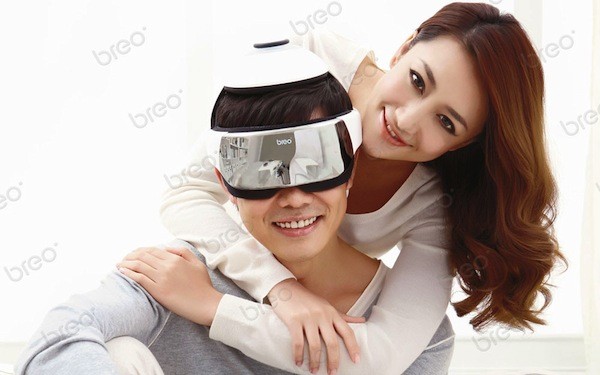
Breo iDream 3 Eye and Head Massager
“Sleep issues are often the result of an overactive mind in bed time,” a promotional video suggests. But tools like these don’t belong exclusively to the realm of gadgetry. There is, in fact, a parallel history of devices designed to “relieve” overactive minds, a history made less of products than dystopian design projects, sound compositions, and multimedia environments conceived since the 1960s by artists and designers speculating on the lysergic properties of technology. Interestingly, these “proposals” fit in the contemporary discourse about “accelerationism” in opposition to the “machinic” nature of gadgets that induce consensus towards capitalism like the mask mentioned above.
Loosely associated with “Speculative Realism”, “Accelerationism” is one of today’s most debated terms in political theory, media studies, philosophy, and art circles. It is used to interpret those forms of resistance to capitalism that “accelerate” the language and aesthetics of capitalism itself, with exclusive attention paid to technology employed as both medium and content of intellectual and visual speculations. One of the effects of accelerationist thought has been a renewed role given to science fiction, based on its intrinsic ability to reflect on the technocratic present and our interdependence with machines, through the imagination of the future or concurrent otherworldly realities.
“Science fictions become the new currency of an ever-expanding future,” wrote J.G. Ballard in 1971. “SF is the subject matter of everyday life: the gleam on refrigerator cabinets, the contours of a wife’s or husband’s thighs passing the newsreel images on a color TV set, the conjuncture of musculature and chromium artifact within an automobile interior, the unique postures of passengers on an airport escalator.”2 In other words, science fiction – in literary but also visual terms – is a tactic of hyper-realistic simulation and “acceleration” of aspects of reality to such a degree that it becomes alienating.
Dream Machines and Mind Expanders
An instructive start in tracing the history of alternative relaxation devices for overactive minds is Brion Gysin’s Dream Machine (1960), a stroboscopic flicker that produces visual stimuli. Its aim is apparently similar to that of sleep-inducing gadgets mentioned above: to accelerate the brainwave frequency of the user towards an alpha state, at which point it begins to “dream.” What differs is the purpose: whereas gadgetry like the Glo to Sleep™ mask help an overactive mind to find relief in order to be ready for another day of overactivity, the Dream Machine fosters an escape from everyday life.
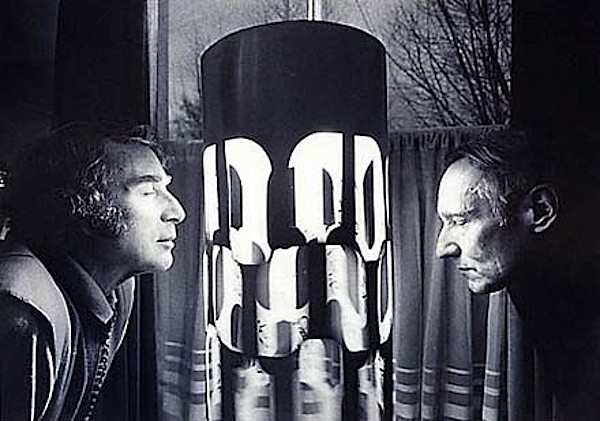
Brion Gysin, Dream Machine, 1960
The exposure to light interruptions at a rate of 8-13 flashes per second synchronizes with the brain’s alpha rhythms, making visible colors, abstract figures and landscapes before one’s eyes. Co-developed with electronic technician Ian Sommerville – and registered in 1961 with patent number P.V.868,281 – Gysin tried unsuccessfully to market it his whole life. Despite the support of influential arts patrons Helena Rubinstein and Peggy Guggenheim, and later underground icon Genesis Breyer P–Orridge, the Dream Machine never became a commercial product, although one can purchase a version of it online or download the instructions to assemble one.
Born in England in 1916 from Canadian parents, Gysin moved to Paris in 1934 to study at the Sorbonne. There he joined the Surrealist Group, to be soon expelled by André Breton, leader of the movement. Ironically enough, however, the Dream Machine has become a posteriori the quintessential incarnation of surrealism, concretizing ideas about dreaming at the core of the avant-garde. “The Dream Machine,” observed Gysin, “may bring about a change of consciousness inasmuch as it throws back the limits of the visible world and may, indeed, prove that there are no limits.”3
Surrealist painting “represented” dreams either figuratively or through abstract composition techniques based on randomness and chance (i.e. frottage, automatic writing), whereas the Dream Machine broke with the two-dimensional tradition of painting and allowed any potential user of the flicker to see things that until then were exclusive domain of artists and visionaries. In doing so, Gysin not only speculated on the concrete and democratic application of surrealism to the everyday, but proposed a lifestyle where technology could be also a tool of liberation against the power structures that control bodies and minds.
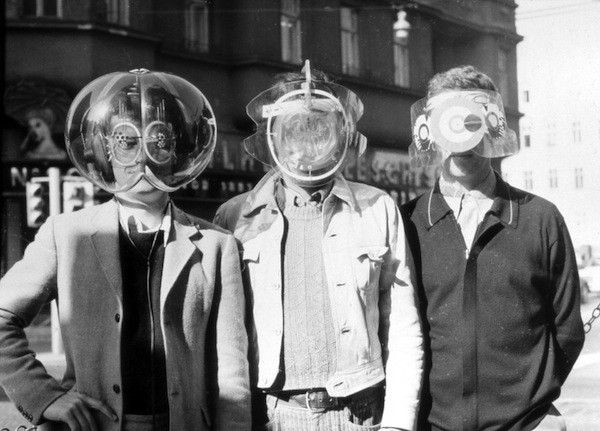
Haus Rucker Co., Flyhead, Environment Transformer, 1968
Throughout the 1960s, other technological experiments in art and design likewise carried social and political implications. Austrian architecture collective Haus Rucker Co. invented machines that similarly aimed to bring the user into an alternative reality. Flyhead, Environment Transformer (1968), for instance, is a sci-fi-looking helmet that modifies visual and acoustic senses. Isolated by the translucent green double hemispherical mask, the user perceives reality through prismatic eyepieces that are supposed to facilitate the perspective of a fly. Audio-visual filters alter the surrounding reality and forces the user to rely on different sensorial properties.
The idea behind Haus Rucker Co.’s projects at that time was to suggest the need for expanding perception as a way to react to the increasingly overwhelming technological environment. Like Flyhead, the Mind Expander (1968) is a series of futuristic plastic armchairs that isolate the sitter, propelling the search for advanced phases of self-awareness via sensory-deprivation. Topped with double-space helmets, made of transparent plastic visors and inflatable elements, these structures do not merely employ technology as much as they exploit the popular appeal of science fiction, offering a playful experience that is also a critical response to consensual reality controlled by technology.
Contemporary gadgets like the Glo to Sleep™ mask adopt the same isolationist approach, offering an individual the experience of self-removal from the surrounding environment. Watching blue glows dimming, however, is a sort of hypnotizing activity where one is completely isolated and somehow suspended, while entering a journey towards the Alpha state. Gysin’s and Haus Rucker Co.’s devices, instead, bring the user to a state in which one is supposed to “reopen” the eyes. The real difference, then, lies in the idea of the “dream,” proposed as a revolutionary activity of both resistance and experimentation with alternatives by surrealists artists.
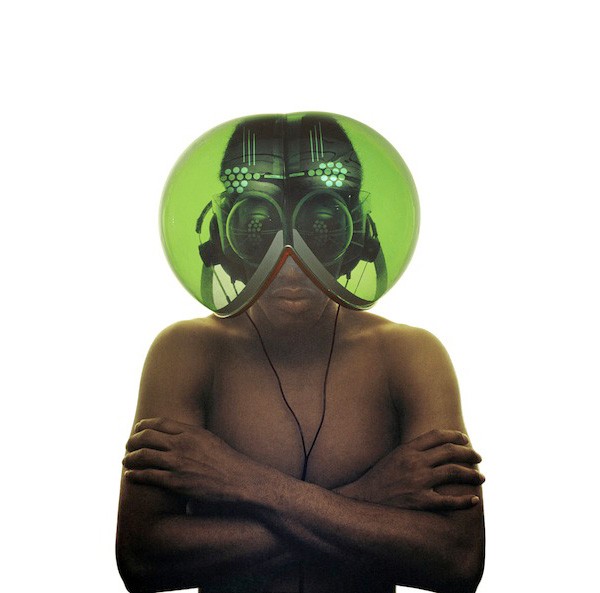
Haus Rucker Co., Flyhead, Environment Transformer, 1968
The Collective Unconscious
Similar ideas inform the coeval psychedelic culture, which rose in concert with the diffusion of LSD for both transcendental and therapeutic use. Within psychedelia, however, artists did not experiment with isolationist devices like Gysin’s and Haus Rucker Co.’s, but instead constructed environments— or relational spaces—to be shared. Light shows, for example, popular accompaniments to psychedelic rock concerts, transformed ballrooms and music halls into liquid galaxies that gave the illusion of absence of gravity. With spectacles like The Joshua Light Show to surround concerts of bands like Jefferson Airplane, known Cartesian dimensions lose consistency, generating the perception of an “unlimited” and networked mental space.
Despite anticipating later forms of installation and new media art, light shows have thus far remained countercultural phenomena alongside with coeval multimedia environments by New York collective USCO and the activities conducted by Californian group Merry Pranksters inside their legendary Magic Bus. Whether it is a liquid light show or the décor of a school bus touring to initiate the US to LSD, the environments of 1960s psychedelia were meant to induce relaxation and an escape from everyday reality, through diverting the purpose of advanced technical inventions (from mainstream entertainment to light shows) and scientific discoveries (from anxiety treatments to psychotropic drugs).
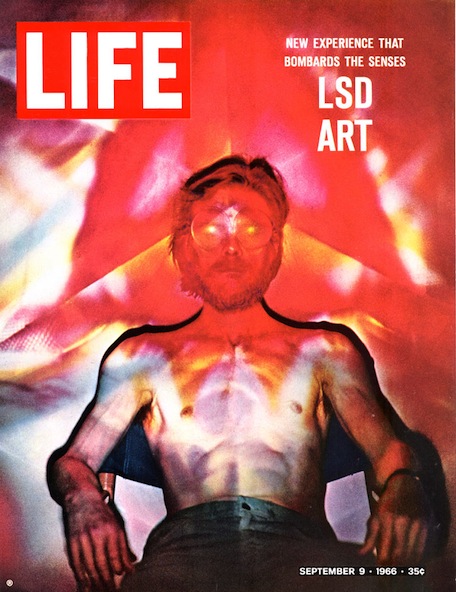
USCO, cover of LIFE Magazine, September 9, 1966
To more clearly understand these experiments, we should take into account the changes in postwar cities brought by new infrastructures like highways and airports, or what Marc Augé in the 1990s famously called non-places.4 The transparent, symmetrical, and “infographic” nature of the architecture of non-places was echoed in soporific yet functional electronic sounds broadcast by hidden speakers in offices, elevators, airports, and later, shopping malls. Muzak, also known as Elevator Music, was set to very simple melodies and played in loop with the aim of slowing down movements and inducing relaxation.
Electronic musicians, on the other hand, began to experiment with compositions that resembled anonymous and generic Elevator Music, developing what today we generically call Ambient. Over the past fifty years, synthesizer music has become a vehicle to comment on the technological infrastructures of the contemporary city: autobahns, trains, and pocket calculators for Kraftwerk; airports for Brian Eno; suburban decay for Aphex Twin; software for Carsten Nicolai; retrofuturistic media for Oneohtrix Point Never; and mirages of consumerist culture for early 2010s Vaporwave.
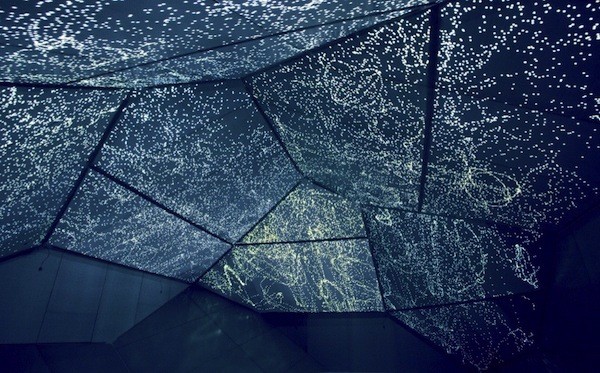
Carsten Nicolai, Syn Chron, 2005
What these all have in common is the way the musicians divert the purpose of strategic sounds originally conceived as soundtrack of the status quo, and in the process reveal and critique their silent—yet coercive—mechanisms. The use of sound to comment on technology is even more efficient in multimedia installations. Representative is Nicolai’s Syn Chron (2004), a crystal-shaped apparatus synchronizing light and sound through its external surface and its internal acoustic chamber. A synaesthetic experience which echoes USCO’s environments and psychedelic light shows, Syn Chron stands halfway between a calming habitat and a machine of aversion therapy like the infamous one used to rehabilitate Alex in Stanley Kubrick’s A Clockwork Orange (1971).
A psychedelic meditative component characterizes Mariko Mori’s Wave UFO (1999-2002), an architectural structure that speculates on a philosophy of the cosmos tracing trajectories between ancient and alien civilizations. Past the oval-shaped bubble door, three users lay down on ergonomic beds and through sensors they experience watching their brainwaves projected on the doomed ceiling above. This real-time biofeedback animation is followed by a video that links the individual experience to an ethereal universe where all the elements are cosmically connected to each other. A survey on the users’ brainwave status shows different degrees of consciousness from Beta to Alpha to Theta Waves.
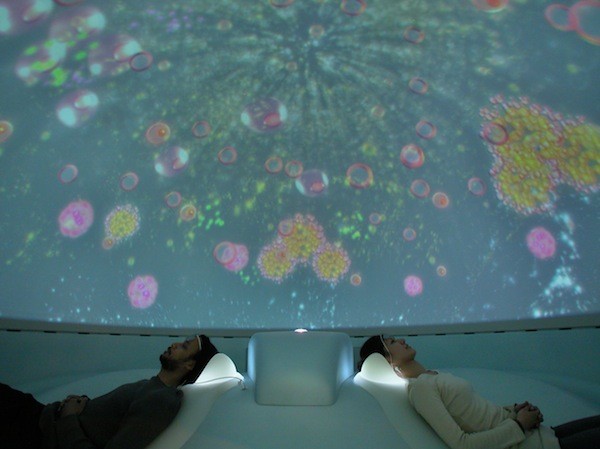
Mariko Mori, Wave UFO, 1999-2002

Mariko Mori, Wave UFO, 1999-2002
Some of the elements described above have recently taken a peculiar direction for the thesis supported so far. Biofeedback devices are the core of the quantified self movement; goggles are often employed by artists and designers to experiment with VR and augmented reality. In both cases, the agents are seduced by technological promises of hyperrealism and mapping such that the distinction between endorsement and critique of reality is never quite clear. Within the current accelerationist discourse, instead, the brief evolution of alternative relaxing apparatuses traced above demonstrate how forms of critique could be achieved through metalinguistic tools that offer relaxation from technology through technology; relief from data overdoses through data stimulation — prefiguring, like Gysin suggested, a world in which technology can bring a change in consciousness that transcends the limits of the visible.
Francesco Spampinato is a New York-based contemporary art historian, writer, and artist. He is Adjunct Professor at Rhode Island School of Design (RISD), Providence, and Ph.D. candidate in Arts et Média at Sorbonne Nouvelle, Paris. He is the author of Come Together: The Rise of Cooperative Art and Design, Princeton Architectural Press, New York (2015).
1 Glo to Sleep – Sleep Therapy Mask, Brookstone.com, accessed February 8, 2015, http://www.brookstone.com/glo-to-sleep-sleep-therapy-mask
2 J.G. Ballard, Fictions of All Kinds, 1971 in Robin Mackay + Armen Avanessian, eds., #Accelerate: The Accelerationist Reader, Urbanomic Media LTD, Falmouth, UK 2014
3 Brion Gysin, interviewed by Jon Savage, date unknown. Transcript included in RE/Search Issue 4/5, 1982
4 Marc Augé, Non-Places: Introduction to an Anthropology of Supermodernity, Verso, London 1995